Basilica Cistern | Discovering Istanbul's Sublime Treasure
Basilica Cistern Skip The Line Guided Tour
Facts About Basilica Cistern
- The Basilica Cistern, often dubbed the Sunken Palace, stands as the grandest extant Byzantine Cistern in Istanbul's heart.
- Renowned as the Yerebatan Cistern, this ancient structure boasts a formidable storage ability of approximately 80,000 cubic meters of water.
- The Basilica Cistern history spans over two millennia, making it a testament to ancient engineering and architectural brilliance.
- Comprising 336 unique columns, the Basilica Cistern offers a deep dive into Byzantine craftsmanship and design.
- Historically significant, another one of the many Basilica Cistern facts suggests that this cistern once efficiently supplied water to the Great Palace and its neighbouring edifices, leveraging expansive aqueducts that originated near the Black Sea.
- Despite its significance, the Basilica Cistern fell into disuse following the migration of the Byzantine emperors, only to be rediscovered by Petrus Gyllius in 1545.
- Beyond serving the Grand Palace, this cistern played a crucial role in supplying water to Byzantium, the city itself, making it among the major Basilica Cistern facts.
- Its moniker, Basilica Cistern, is derived from the Stoa Basilica square that historically loomed above the cistern.
- As a beacon for history aficionados, the Basilica Cistern Museum notes that the Sunken Cistern attracts over 2.2 million global visitors annually.
- The cistern measures 453 feet in length and 212 feet in width, making it one of the largest surviving cisterns in all of Istanbul.
- Its cinematic appeal is undeniable, having featured in renowned movies such as "From Russia with Love" (1963) and "The International" (2019).
Plan Your Visit to Basilica Cistern
- Weekly Opening days: You can plan your Basilica Cistern visit, as the attraction is open every day of the week.
- Day timings: The Basilica Cistern opening hours are between 09:00 AM to 10:00 PM on all days of the week.
- Duration Of Visit: The duration of your Basilica Cistern visit typically ranges between 30 minutes to 2 hours. Its vast size, 336 unique columns, detailed craftsmanship, especially the captivating Basilica Cistern Medusa heads, informational guides, and the allure of photography contribute to the duration. Peak visitor times might extend your stay, allowing a deeper appreciation of its historical significance.
Location: The Basilica Cistern is located in Istanbul, Turkey, on the historical peninsula of Sarayburnu. The official Basilica Cistern location is Yerebatan Cad. Alemdar Mah. 1/3 34410 Sultanahmet-Fatih, Istanbul, Turkey.
How To Reach
- By Bus: You can easily avail a bus ride on bus 28, 30D, 46C, 54E, 66, 77A, 92C, 99A or EM1 and get off at the Eminonu-Iskele- Yesilkoy Yonu bus stop, located around 1.6 kilometres from Medusa Istanbul Basilica Cistern. From the stop, you can reach the attraction by walking for around 5 to 7 minutes.
- By Tram: You can take the T1 tram from Aksaray to the Sultanahmet tram station, which is located just 280 metres, or an approx 2-minute walk from Byzantine Cistern.
- By Train: There are no direct trains to the Basilica Cistern Museum. However, you can avail a ride on the B1 Marmaray train from Atakoy to Pendik or Marmaray train from Halkali to Gebze, and get off at the Sirkeci Station. It is located 1.1 kilometres from the Cistern and takes around 7 minutes by walking to reach.
- By Metro: Taking the M2 metro is a very convenient way to reach the Basilica Cistern. You can get off at the Marmaray Sirkeci Station, located 1.1 kilometres, or a 7-minute walk away from the Cistern.
- By Car: The Yerebatan Cistern is located in the Fatih district of Istanbul, around 4.3 kilometres away from Istanbul city centre. It will take you anywhere between 25 to 40 minutes to get to the Cistern from the city centre. Upon reaching, you can park your vehicle in designated parking spots at Dalbasti Parking, Ispark 540, and Kabasakal Medrese Onu.
The Basilica Cisterns is a phenomenal year-round attraction that you can visit and enjoy.
1. Best Season: The best time to visit the Cistern is in the springtime between March to May or in the Autumn between September through October. The temperatures are milder and better to explore the depths of the Cistern during this time
2. Best day in the week: It is best to visit the attraction on weekdays as it is less crowded during this time giving you a more tranquil time to explore the Cistern
3. Best time of the day: Visiting in the early mornings and late afternoons is the best time during the day to visit the Cistern
Things to See in Basilica Cistern
Two spooky Medusa heads, one placed sideways and the other upside down, gaze ominously from the columns of the Basilica Cistern. The Basilica Cistern Medusa Heads are ancient relics believed to have been repurposed from pagan structures, adding an air of mystery to the underground reservoir. The appeal lies in their haunting beauty and the myths surrounding their placement. Legend has it that their positioning was to ward off evil spirits, making it both a captivating sight and a symbol of the cistern's enigmatic past.
Amidst the symphony of Basilica Cistern architecture, the Weeping Column stands with an impressive narrative. Constantly wet, as if mourning, it is a heartfelt ode to the countless slaves who met their untimely end during the Basilica Cistern's construction. The Basilica Cistern history reveals that the intricately carved peacocks symbolize immortality, and the drooping branches might signify sorrow. This column serves as a tactile reminder of the sacrifices made during its construction; a site visitors can glance at with their Basilica Cistern Tickets.
Beyond the grandeur of the main Yerebatan Cistern expanse awaits a covert treasure: the Secret Tunnel. Historically pivotal, this passage once transported life-sustaining water to the illustrious Topkapi Palace. The tunnel stands as a testament to the Byzantine Cistern era's architectural prowess, its dimly lit confines allow visitors to momentarily relive the mystique and significance of the ancient waterway.
The Basilica Cistern is more than just a historic reservoir or a tourist spot covered by the Basilica Cistern Museum it is a place of reflection. The serenity of the water's surface, occasionally broken by gentle ripples, casts ethereal reflections of the overhead architecture. This play of light and shadow, combined with the sound of droplets, creates a meditative ambience, urging visitors to pause and immerse themselves in the Basilica Cistern history.
Your journey into the heart of the Basilica Cistern Museum begins with the descent of a 52-step stone staircase. Each step unravels the enormity of the Sunken Palace, gradually revealing the vast array of columns and shimmering waters below. This entrance, a blend of form and function, symbolizes a transition from the bustling world above to the mesmerizing realm of the Basilica Cistern.
The Basilica Cistern's spine is undoubtedly its 336 magnificent marble columns, a core component of the Basilica Cistern architecture. Each column, with its distinct artistry, echoes tales of a vibrant past. From the unembellished beauty of the Doric style to the intricate flourishes of the Corinthian, these columns encapsulate the Basilica Cistern history. Whispers amongst historians suggest that some might have been reclaimed from the once-majestic Forum of Theodosius, adding depth to the Basilica Cistern facts known today.
Within the Basilica Cistern's dimly lit chambers, several wooden walkways crisscross over the tranquil waters below. These walkways add an element of mystery and charm to the underground reservoir, inviting exploration and contemplation. The wooden walkways not only provide practical access but also enhance the ambience. It offers a unique perspective of the cistern's vastness and serves as a pathway for guided tours, enriching your experience.
The still Reflective Waters in the Basilica Cistern serve as a mirror, reflecting the mesmerising beauty of its arched ceilings and ancient columns. The reflective surface creates an illusion of endless depth, adding to the cistern's mysterious allure. The tranquil ambience and the ethereal quality of the waters make it one of the most attractive features of this Byzantine Cistern. Beyond its aesthetic appeal, the reflective waters were once crucial for assessing the cistern's water levels, ensuring the city's survival during times of need.
History of Basilica Cistern
Emperor Constantine initially laid the foundation for what would become the Basilica Cistern in the heart of Constantinople. However, it was Emperor Justinian I, a prominent figure in Basilica Cistern history, who expanded and completed it after the devastating Nika riots in 532. When you delve into your Basilica Cistern visit, you'll learn how Justinian, the same emperor who gave us the Hagia Sophia, utilized around 7,000 slaves for this massive project. Their labour transformed a once magnificent basilica into what locals called the Yerebatan Cistern or Sunken Palace, aptly named for its underground columns.
Originally situated under the Stoa Basilica, this Byzantine Cistern served as a vital water reservoir for the Great Palace of Constantinople and the surrounding buildings on the First Hill. Even after the Ottoman conquest in 1453, it continued to hydrate the Topkapi Palace. Over time, the significance of the Basilica Cistern diminished, and its existence became a whispered legend among locals. It was only in 1565 that a French traveller, Petrus Gyllius, rediscovered it, intrigued by stories of residents fetching water, and occasionally fish, from this subterranean marvel.
The Basilica Cistern, or as you might find in some Basilica Cistern facts, the Medusa Istanbul Basilica Cistern, was constructed during the 6th century. Its placement is about 150 meters southwest of the Hagia Sophia, making it a focal point on the historical peninsula of Sarayburnu. While the initial concept might date back to Emperor Constantine’s time, the monumental work and final architectural beauty, seen when you make your Basilica Cistern entrance, is attributed to the reign of Byzantine Emperor Justinian I.
Architecture of Basilica Cistern
In the heart of Istanbul, the Basilica Cistern, also dubbed the Sunken Palace or Yerebatan Cistern, stands as a testament to the grandeur of Byzantine Cistern architecture. Spanning an expansive area of 9,800 square meters, the Basilica Cistern architecture reveals itself in its 336 masterfully carved columns. As visitors descend a 52-step staircase, the essence of Basilica Cistern's history envelops them. These columns, which intriguingly have origins in older structures, are a blend of diverse marbles, exhibiting the finesse of both Corinth and Doric styles. The 4.80-meter thick brick walls, a core component of the Basilica Cistern architecture, are plastered with robust Horasan mortar ensuring longevity and impermeability.
Located near the Hagia Sophia, the Basilica Cistern Museum underwent a transformative restoration. The Basilica Cistern Visit was paused in 2017 due to potential earthquake threats. However, after five dedicated years, it was rejuvenated, with the Basilica Cistern entrance welcoming visitors to experience its renewed splendour. The latest restoration introduced a footbridge and enhanced lighting, revealing details reminiscent of the Medusa Istanbul Basilica Cistern era. Presently, the Yerebatan Sarnıcı stands strong against nature's furies and disasters. Additionally, it also mesmerizes visitors with light shows and art installations, making every Basilica Cistern visit an unforgettable journey through history.
Tips to Visit Basilica Cistern
FAQs of Basilica Cistern
Which are the best places to visit near the Basilica Cistern?
- Blue Mosque: Located near the Yerebatan Cistern, this historic Blue Mosque is renowned for its six minarets and impressive blue tiles that adorn its interior. When you marvel at its intricacies, you're witnessing centuries of religious and architectural evolution, making it a perfect complement to your Basilica Cistern visit.
- Hagia Sophia: Located just 14 metres away from Basilica Cistern entrance, Hagia Sophia stands as a testament to Byzantine grandeur. Its massive dome, intricate mosaics, and the synthesis of Christian and Islamic elements showcase a city and structure at the crossroads of two worlds.
- Topkapi Palace: After being delighted by the Medusa Istanbul Basilica Cistern, this expansive palace offers a journey through Ottoman history. Exhibiting treasures from the Prophet Muhammad, vast courtyards, and the sultans' opulent harems, it paints a vivid picture of an empire's luxurious past.
- Dolmabahce Palace: Contrasting the underground allure of the Sunken Palace, Dolmabahce Palace dazzles with European flair. Overlooking the Bosphorus, its lavish rooms, crystal chandelier, and meticulously landscaped gardens echo a period of modernization and Western influence in the Ottoman realm.
Are there guided tours available at Basilica Cistern?
Yes, there are guided tours available at the Basilica Cistern. Engaging in a Basilica Cistern tour gives visitors a deeper understanding of the Basilica Cistern history. With knowledgeable guides leading the way, tourists can immerse themselves in stories and facts about this impressive Byzantine Cistern, making the Basilica Cistern visit even more memorable.
What is there to see inside Basilica Cistern?
Some of the highlights of the Basilica Cistern are:
- Medusa Heads: Among the forest of marble columns two Medusa heads stand out. Their enigmatic gaze adds an aura of mystery to the Basilica Cistern. Legend has it they were placed sideways and upside down to ward off evil spirits or they symbolise pagan rituals that were practised then.
- Reflective Waters: The still waters of the cistern act like a mirror that reflects the intricate architecture above. You will be mesmerised by the ethereal beauty of the waters, which add to the Cistern's mystical ambience.
- Wooden Walkways: The wooden walkways crisscross over the water, providing pathways for exploration while enhancing the mystical charm of the Cistern. These walkways offer a unique perspective of the underground reservoir and its grandeur.
- Ancient Architecture: Marvel at the grandeur of the Cistern's architectural features, including its impressive vaulted ceilings, towering columns, and intricate carvings, all remnants of Byzantine craftsmanship and engineering ingenuity.
Is photography allowed at the Basilica Cistern?
Yes, photography is permitted inside the Basilica Cistern. It's a haven for photographers, capturing the interplay of light and shadow on ancient columns, reflections on the water surface, and the iconic Basilica Cistern Medusa sculptures. A Basilica Cistern visit presents a unique opportunity to document a piece of Istanbul's rich heritage.
Is there a dress code for visiting the Basilica Cistern?
While there isn't a stringent Basilica Cistern dress code, visitors are advised to wear modest and comfortable attire, keeping in mind the cultural and historical significance of this Byzantine Cistern. Dressing respectfully ensures a comfortable visit while also paying homage to its storied past.
How to reach Basilica Cistern?
To reach the Cistern, you can take the Marmaray train and alight at Sirkeci Station which is the nearest stop. By Tram you can hop on the T1 Line, disembarking at Sultanahmet Station. If you prefer buses you can board the HAVAIST Bus, alighting at Sultanahmet Bus Stop. Additionally, you can take the metro - M11 or M1A lines and get down at Yenikapi Station, the closest metro stop to the Cistern.
What Is Special About Basilica Cistern?
The Basilica Cistern is a marvel of ancient engineering. Known as the Sunken Palace, it showcases Byzantine mastery in architecture and utility. The fusion of history, and artistry in the form of the Basilica Cistern Medusa carvings, and the ambience make it a standout landmark in Istanbul.
What Time Does Basilica Cistern Open?
The Basilica Cistern opening hours generally commence from 09:00 a.m. However, the Basilica Cistern timings might differ based on seasons or special events. Before planning your visit, it's prudent to verify the timings to make the most of your experience.
Is Basilica Cistern Worth It?
Yes, the Basilica Cistern is definitely worth a visit. Its unparalleled beauty, combined with the deep Basilica Cistern history, sets it apart. The serene waters, architectural grandeur, and tales of the Sunken Palace make it indispensable to Istanbul's cultural scene.
What movies was filmed in the Basilica Cistern?
The atmospheric depths of the Basilica Cistern have been a draw for filmmakers. Most famously, it was a location for the James Bond movie "From Russia with Love." Its ethereal setting naturally complements cinematic storytelling, amplifying the charm of the Sunken Palace.
Why is it called Basilica Cistern?
It's named the Basilica Cistern because of its historical roots. Originally constructed beneath a grand basilica or public square during the Byzantine era, the term 'cistern' signifies its primary function as an expansive water reservoir, illustrating its dual purpose in architecture and utility.
How much is entry to Basilica Cistern?
The Basilica Cistern Price or Basilica Cistern Entrance Fee is generally around 450 Turkish Lira, which is around INR 1341.59 per person. However, prices may fluctuate based on seasons or special events. It's always wise to check the current rates in advance to ensure accurate budgeting for your Basilica Cistern visit.
Are there concerts in Basilica Cistern?
Yes, the Basilica Cistern occasionally hosts concerts. The acoustics within this Byzantine Cistern, combined with its unique ambience, make it an unparalleled venue for live performances. These concerts immerse attendees in an auditory and visual spectacle amidst the historic surroundings of the Sunken Palace.
Who designed the Basilica Cistern?
The Basilica Cistern or Sunken Palace was commissioned by Emperor Justinian I and it was designed by architect Tralles in 532 AD. The Cistern was constructed using 366 columns and was built to store and supply water to the imperial palace and the buildings around it. The storage capacity of the Cistern is around 100,0000 tonnes of water.
When was the Basilica Cistern built?
The Basilica Cistern was built in 532 AD by Emperor Justinian I to store and supply fresh water to the city of Constantinople which is now Istanbul. The Cistern is the largest surviving Byzantine Cistern in the region and it was built using 366 columns.
Is the Basilica Cistern wheelchair accessible?
Yes, the Basilica Cistern is wheelchair accessible. The exit on the side of Alemdar Street has a wheelchair platform lift that will get you down the stairs. It is advised to carry your wheelchair as the sight may offer spare chairs.

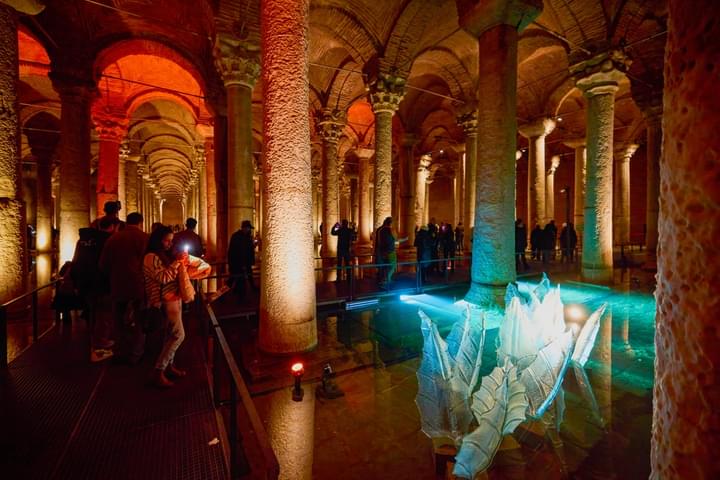
.jpg?w=360&dpr=2)
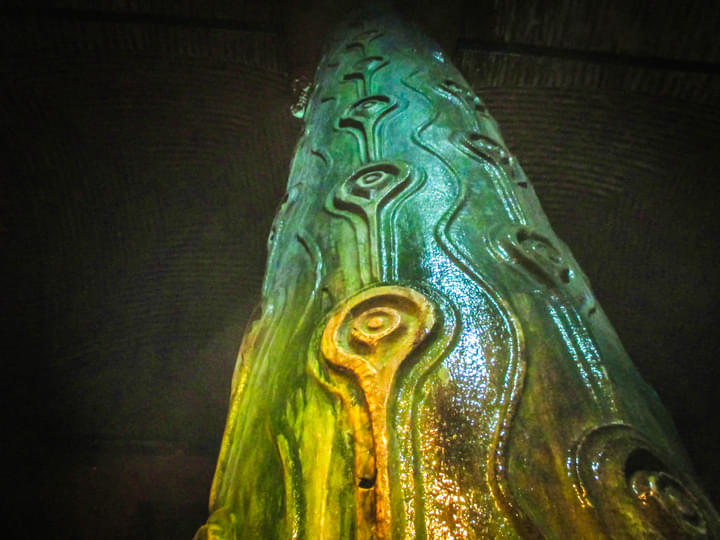
.jpg?w=360&dpr=2)
.jpg?w=360&dpr=2)
.jpg?w=360&dpr=2)
.jpg?w=360&dpr=2)


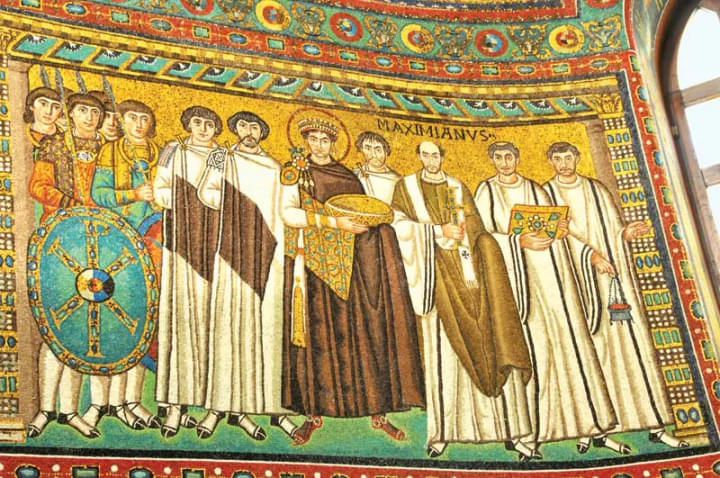

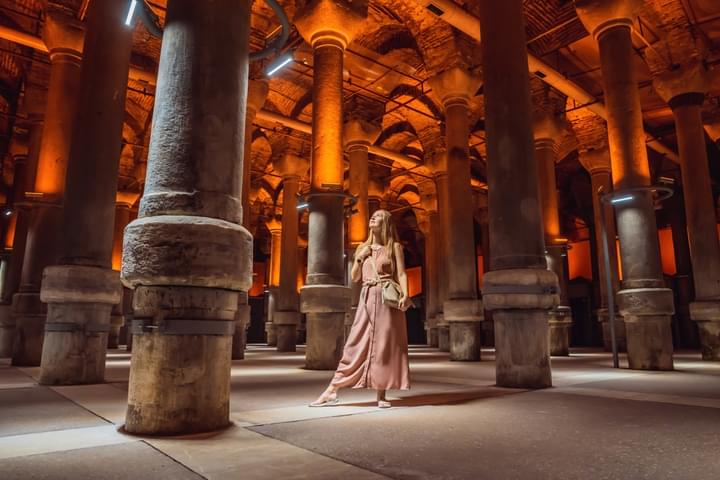
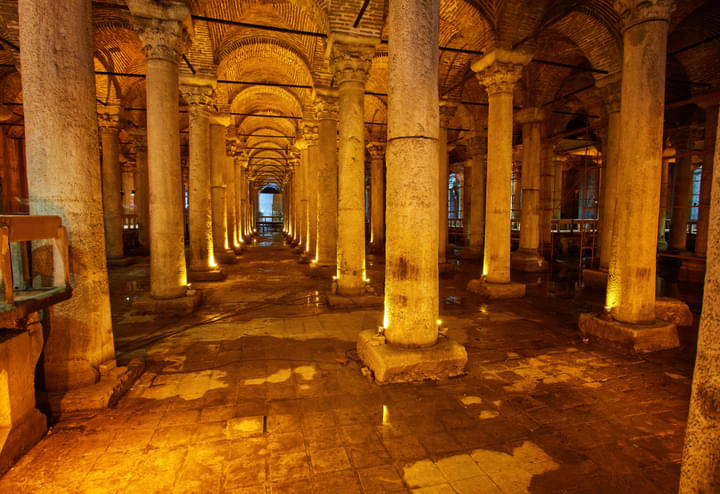
.jpg?w=360&dpr=2)